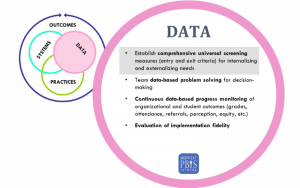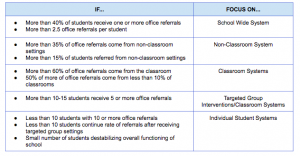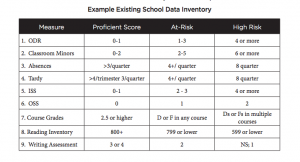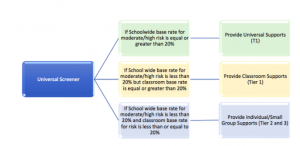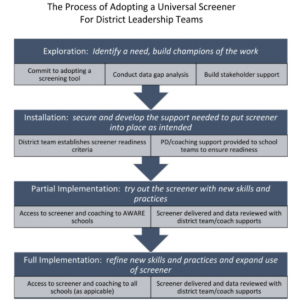What is universal screening?
One aspect of a comprehensive assessment system in the context of a Multi-Tiered System of Support (MTSS) is universal screening. Universal screening involves the collection and review of multiple measures to assess the academic and behavioral health of all students. Screening data simply indicates there is a potential problem with a student, class, grade or school that warrants a closer a look.
Click the image from our friends at Midwest PBIS to see how universal screening fits into the overall purpose of data in your MTSS.
Okay… but we already collect data, right?
Yes, and that data helps to answer various types of questions. In the context of implementing a multi-tiered system of support (MTSS) teams should consider four types of data sources to inform systems and practices for all, some and a few students:
| Screening: | to identify potential problems that warrant a closer look |
| Diagnostic: | to understand root causes of identified problems |
| Progress Monitoring: | to inform adjustments/enhancements to existing interventions |
| Outcome: | to determine if instructional changes were effective for systems decisions |
Don’t we just need to buy a screener or wait for an educator or parent to request help?
A comprehensive universal screening process should proactively capture the full range of behavioral and mental health problems seen in our schools in order to identify youth in need of intervention and inform universal, group and individual interventions. While typical referral pathways such as requests for assistance are an effective way to find students with more significant needs, additional data sources can help teams intervene earlier.
A comprehensive screening process will include:
- Nominations/Recommendations such as teacher, parent or student requests for assistance
- School-wide data such as attendance, office discipline referrals and course grades
- Brief research-based screeners that align with the prioritized prosocial behaviors or emotional and behavioral risk factors of the school or district (Dowdy, Raines, James-Furlong and Kamphaus, 2015).
I didn’t realize school-wide data is part of our screening process. How should we be using it?
First, use your existing school-wide data such as attendance rates, ODRs, assessment data, grades etc. to determine the current overall response to your Tier 1 system. To do this, your team should establish what is considered proficient in your school (see below for a sample) for existing school-wide data to generate a base rate (or percentage of students) showing risk across measures. You can compare this information, to the expected base rates in the tiered intervention model (80%, 15%, 5%) to differentiate and/or intensify Tier 1, Tier 2 and Tier 3 support. Typically students identified as at risk or high risk are considered for targeted or individual interventions but teams may find the percentage of students in these categories indicate a need for school, grade or classroom level problem solving (see samples below).
Sample Decision Making Matrix using Office Discipline Data:
Sample existing school data inventory from PBISmissouri:
Sample Tier 1 problem solving with screening data from Project AWARE Georgia
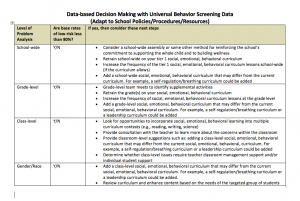
For more information, please visit the following links:
- Tier 1 Program Development and Evaluation: learn more about using school-wide data for Tier 1 decision making please in the data analysis section.
- Tier 2 Tools: learn more about using school-wide data to inform Tier 2 intervention decisions in the data tools section.
Our schools don’t have the resources to support all the needs identified by adding a screening tool. What should we do?
Remember, universal screening data simply indicates a problem might exist. It signals that more information is needed to understand and support your staff and students. For example, if your data indicates more than 20% of students in your school or classroom demonstrate risk your teams should get to work on universal or classroom level supports!
Click the image below to see an example of decision making with screening data developed by Kilgus & Eklund, 2015.
What makes an effective screening measure?
Universal screening measures range from district developed surveys to standardized tools for specific types of skills. However, to ensure the tool is a screener and not a diagnostic measure the following characteristics should be considered:
- May be administered to an entire classroom/grade/school/district, using either individual or group format
- Are aligned with the school or district’s core instructional focus
- Serve as an indicator that there is a potential problem that warrants a closer look at who and how many
- Are time-efficient and cost effective
- Administered, scored, and interpreted the same way
- Provide a sample of prioritized need at one point in time
- Leads to proactive decision making
Do you have a list of recommended screening tools?
We do! However, we recommend schools work with their district level MTSS leadership team to engage in a process to select and implement a screener that supports the mission and vision of the larger district. District support is especially important, because adopting a screener requires stakeholder support, legal guidance, financial resources and coaching.
Our team at the DE-PBS Project is working with partner districts through the Project DelAWARE grant to develop a process for district leadership teams interested in selecting and installing a screening measure.
Click the image below to see a graphic of the process we recommend.
If you are interested, check out this list of universal screening tools from PBIS.org
Our district isn’t ready to adopt a screener but our school would like to collect some data to help inform our instruction. Any advice?
Sure, we would recommend your school begin with a less formal screening measure. The selection of a tool will depend on the priorities of your MTSS team. For example, teams wishing to measure teacher-student relationships and identify disconnected students can use a Connection Survey. Or, if you wish to identify students who are non-responsive to your universal behavior supports, you might consider using your schoolwide expectations as behavioral screening.
Our district leadership team is ready to install a formal screening tool. Where do we start?
Great! We have developed a screener installation coaching guide to help your leadership team as you progress through the process. The links below contain helpful tools and resources that your team may find helpful along the way!
You may also find this resource for school leaders helpful as you begin to engage with administrators across the district!
Interested in Learning More?
Presentations: universal screening webinars and presentations presented by the DE-PBS Project
Exploration Tools: tools and resources to determine if adopting a screening tool is right for your teams and how to select a screening tool in ways that ensure stakeholder support
Installation Tools: tools and resources to prepare to implement a new screening measure
Implementation Tools: tools and resources to support teams to use screening data for data-based decision making
Additional Resources: additional research and resources related to universal behavioral health screening in schools

